The Women of Unnatipatha Cheli Samiti: The New Entrepreneurs
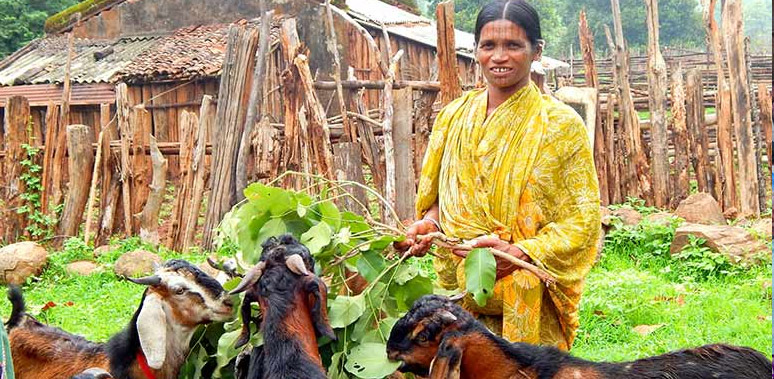
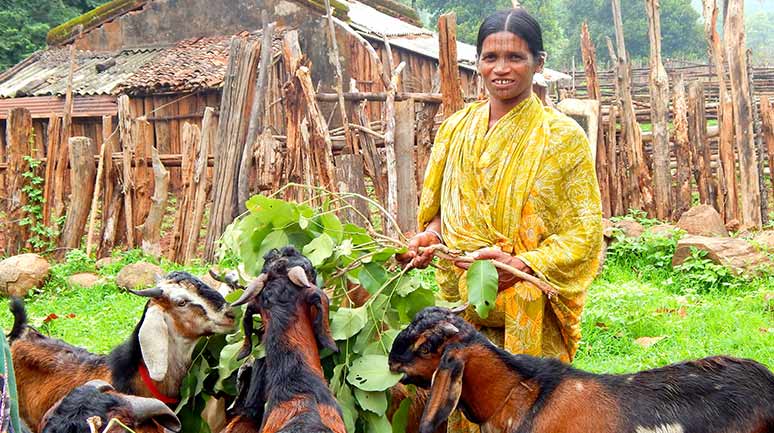
Making a tentative beginning at goat-rearing, the women of Unnatipatha Cheli Samiti taste success and cannot be held back. They now monitor the health of the animals and deal with the markets too; thereby increasing their confidence and decreasing their dependency on men.
“This is not enough. I won’t sellat this price. Take it at Rs 11,000 or leave it,” says Sumanti Mallick. She counts the money given to her and hands over the goat to the buyer.
T his is not a usual scene in a tribal village of Kandhamal. The scenario in this village, however, is changing. Today, the women have begun to negotiate prices in the market space. Sumanti Mallick and many other women of her village,and of some nearby villages too, can now be seen bargaining for a fair price, selling and managing the oney that they earn in exchange for their livestock.
Sumanti Mallick and the women-folk of ‘Unnatipatha Cheli Samiti’, Sudra gram panchayat (GP) are now often seen negotiating with the traders for a fair price. ‘Unnati patha’, which literally means ‘Path to development’, has truly been the conduit for many families towards progress. Five years ago, Kateri Mallick of Jargi village, Sudra GP, in Balliguda block, used to be one of the poorest women. She lived with six family members, had barely any land, and largely survived by relying upon the Public Distribution System to meet the food requirements of her family
Five years ago, Kateri Mallick of Jargi village, Sudra GP, in Balliguda block, used to be one of the poorest women. She lived with six family members, had barely any land, and largely survived by relying upon the Public Distribution System to meet the food requirements of her family
Backdrop
K andhamal is a place of serene beauty, cool climate and dense forests. It has more than 60 per cent of natural forest cover, in highly undulating terrain, receiving an annual rainfall of 1600 mm. The erratic nature of rainfall makes it difficult to fully depend upon an agrarian economy. And because of that, the place is also home to some of the poorest indigenous tribes. It is one of the poorest districts of Odisha, where the average income level of a household (HH) is at subsistence level. An annual income of Rs 30,000 is a distant dream for most HHs.
Five years ago, Kateri Mallick of Jargi village, Sudra GP, Balliguda block, used to be one of the poorest women. She lived with six family members, had barely any land, and largely survived by relying upon the Public Distribution System (PDS) to meet the food requirements of her family.
Kateri Mallick recalls with a sigh, “What to speak about those times, didi. Those days were very difficult for me and my family. We were so poor that we had only one meal a day. I used to go searching in the forest for kandha mula (wild yam), which I then boiled and gave to my children because I could not afford to buy vegetables and oil. I have spent sleepless nights thinking about how to get food for my children the next day.”
She had to survive the year in three sets of clothes; her primary responsibility was to meet the HH expenses because she was the only earning member of her family. Her husband had been paralyzed for the last three years. Collecting sal seeds, stitching siali (bahunia bahuli) leaf plates, day and night, and selling them in the local market hardly fetched her Rs 6,000 in a year. She recounted, with a heavy heart, that she had had to stop sending her children to school because she needed the extra hands at work so that the house could run.
| Kandhamal |
|---|
| BPL: 82%; ST-52%, SC-18%. Literacy |
| (female): 36% Kandha: 91% of the total tribal population |
| Area under forest: 72%, Sal forest |
| Climate: Cool. Annual rainfall: 1600mm |
| Irrigation created: 15%.Cultivatedarea:15%. Fertilizer-consumption:4.8kg/ha |
| Livelihood sources: Agriculture (30%); shifting cultivation (15%); forest produce (30–40%); livestock-rearing (20–25%); wage labour (10%) |
Such was the ordeal that Kateri Mallick and many other women of that area face.
H er suffering began to abate once she decided try improved livestock-rearing activity.Although she didn’t have a single goat to start with, she graspedat straws. She started to save little by little in her SHG; she purchased one goat and then there was no looking back. In 2013, she earned Rs 30,000, which she spent on the education of her youngest son. Now, she has a stock of eight mother goats, six kids and three bucks, and earns around Rs 20,000 per year. She no longer has to spend sleepless nights thinking about the next day’s meal. Once she was a debtor asking for money from others, just to survive; now she saves money herself and even lends it to others.
Similarly, Alanti Mallick, a livestock-rearer of Pipali village and a member of the Livestock Production Cluster, goes to the bank and deposits money in her own account. This is the money she got by selling her goat. The money she earns from goat-rearing is spent on the education of her daughters. She has four daughters, three of who are studying in the capital city. Although she herself has never been to school, she wants her daughters to study and go for higher studies. She talks proudly about her eldest daughter, who has recently joined as a teacher in a private school at a nearby town.
Aalanti Mallick narrates, “I would have never been able to spend Rs 40,000 annually on my daughter’s education if it hadn’t been for livestock-rearing. The money that I got from this, I would divide equally and deposit into my daughters’ accounts for their future security. Now I have 22 goats and 20 poultry birds.”
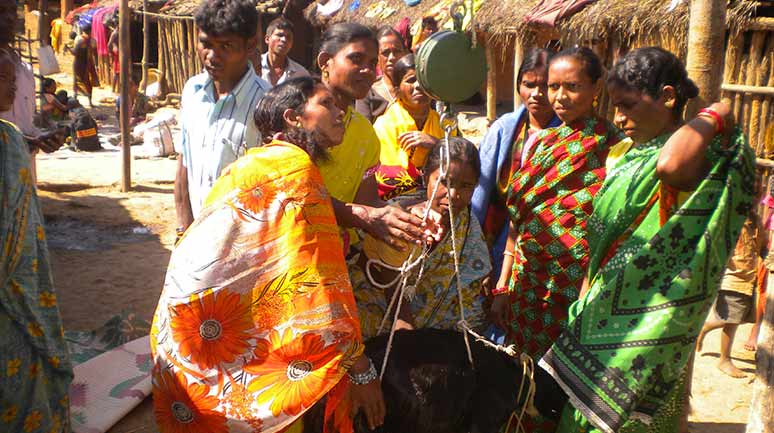
When I asked her whether she ever spent the money for herself of her own will, she smiled and recalled an incident two years ago when her husband was out of town and she sold a doe in exchange for gold jewellery. Her husband had become furious when he returned and saw the doe missing. He called her dumb and asked her how she could sell his goat without his consent. To which she asked him how the goat was his alone when she spent most of her time looking after the goats. She argued that it belonged to both of them and she had an equal right to take a decision about its sale. She had made a profitable deal and was not dumb to waste her own money and resources. Her husband had nothing much to say after that.
Aalanti was smiling while narrating this conversation. The smile not only reflected her victory but also answered many questions. Questions of her status in this institution called marriage, her rights, her ownership, the value for her decisions. A sense of pride was evident in the entire discourse… the pride of having shifted from being a mere wage earner to an entrepreneur.
Perhaps, many such smiles can be seen on the faces of the women of these villages, which speak of their struggles, their efforts and their unique journey that has transformed them from being labourers to owners. These women are members of ‘UnnatiPathaCheliSamiti’, a Livestock Production Cluster, comprising 150 women farmers of four villages and formed in 2010. PRADAN has been engaged in scientific goat- rearing with these women rearers since 2006.
These women are members of ‘UnnatiPathaCheliSamiti’, a Livestock Production Cluster, comprising 150 women farmers of four villages and formed in 2010. PRADAN has been engaged in scientific goat- rearing with these women rearers since 2006.
Journey of Change
T hese women are members of ‘UnnatiPathaCheliSamiti’, a Livestock Production Cluster,comprising 150 women farmers of four villages and formed in 2010. PRADAN has been engaged in scientific goat-rearing with these women rearers since 2006.
In this indigent tribal-dominated area, even an annual income of Rs 10,000 was a tall order. The livelihood of the people was dependent on the collectionof non-timber forest produce (NTFP). The people possessed very little land, and whatever they did was mostly fallow and unproductive. They kept one or two goats. There was no trace of vaccination or medication.
In an area such as this, the biggest battle facing the team was to develop affinity with the community and to mobilize them to come together to save money for themselves. Slowly, after continuous interaction, the people began to trust the team; PRADAN’s journey with the community started with the formation of the very firstwomen’s SHG in the GP, in 2003. When we began working with them, the women didn’t even have any money to save. Each day, they would keep aside one fistful of rice while cooking. They would bring in the rice to the weekly group meetings and save it, in lieu of money. Initially, it was a struggle to make people realize the importance of scientific goat-rearing. Nevertheless, the team started its intervention of mass vaccination and de-worming, in consultation with the community.
Initially, it was a struggle to make people realize the importance of scientific goat-rearing. Nevertheless, the team started its intervention of mass vaccination and de-worming, in consultation with the community.
T here was an urgent need to build their livelihoods avenues. So, in 2005, when doing a survey and resource mapping for livelihoods planning with SHG women, the idea of scientific goat-rearing was conceived by the team. The livestock sector had the potential to provide considerable income, especially for the landless and for people involved in manual labour.
Although livestock was a small part of their livelihood portfolio, it held a great significance in their lives, culturally as well as economically. The animals were used in rituals as sacrifice to pacify Goddess Earth, were given as an asset for their daughters in marriage, or were a buffer for sale during emergencies. Even though livestock was often a shield, insulating families from contingencies, it was not a viable income-generating activity because of the low survival rate of the animals due to disease, especially because vaccination was taboo.
Many diseases were prevalent in the area, owing to which many goats died. Initially, it was a struggle to make people realize the importance of scientific goat- rearing. Nevertheless, the team started its intervention of mass vaccination and de-worming, in consultation with the community. Some of the women wanted to carry out the vaccination but did not because of resistance from the men. The resistance had its links and roots in their cultural traditions.
Through continuous discussions, perspective building and training, 30 members from four SHGs were convinced to start a scientific goat-rearing activity. After much perseverance and efforts, in 2006, the activity was initiated in two villages—Jargi and Kateribhata.
The main objective was to, at first, demonstrate the activity only in a small area, which after its positive outcome could lead to a wider acceptance and adoption of the practice. The women did not even have a single goat to start with, but they availed of a loan from their SHGs and bought goats to start the activity.
Men, on the other hand, were more apprehensive. They had a perception that, after vaccination, there would be more occurrences of diseases that would lead to the death of their animals. Their notion was not completely without basis because it arose from their previous experience in which many goats had died after being given vaccination by the Livestock Inspector (LI) of their area. The men, therefore, did not support the women in their initiative; this was a de- motivating factor and contributed to the snail’s pace start of the activity.
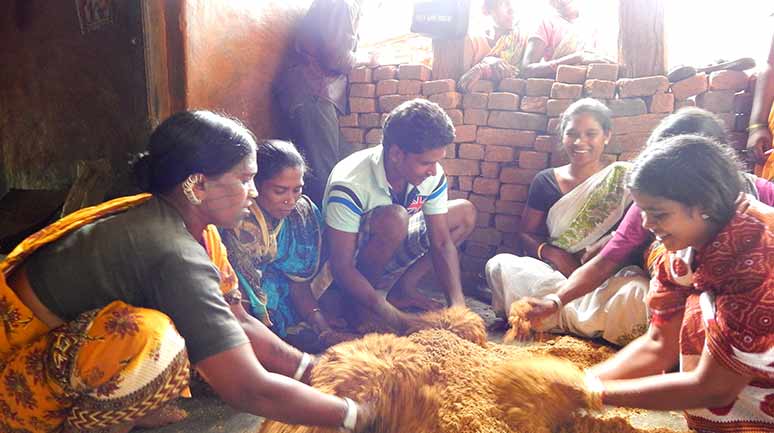
When there was a need to construct a shed for the goats, the men flatly refused to help. They made fun of the women and bragged about how, without their help, the women wouldn’t be able to construct the shed. However, when the going gets tough, the tough get going. And the women lived up to this saying.
The situation made the women more determined. They formed alliances among themselves and worked together, helping each other to construct the shed. They teamed up to build a wooden cart, which they used to get logs from the forest and successfully completed the building. That was a major stepping stone for the women farmers. The men, who were mere spectators, were quite surprised and shocked to see their women working independently. Some of the men were sorry for the stand they took and started supporting the women in their venture. Although the women came forward and engaged in this activity, the control was not in their hands; it was largely driven by their men. In many cases, the indecisiveness of the women and their dependency on the men for taking a decision to spend even a single penny for this activity were evident.
Although the women came forward and engaged in this activity, the control was not in their hands; it was largely driven by their men. In many cases, the indecisiveness of the women and their dependency on the men for taking a decision to spend even a single penny for this activity were evident.
T hat year, there was outbreak of PPR (Peste des petits ruminants) disease (also known as ‘goat plague’) in the area. The families that had not vaccinated their goats lost all their animals. The only goats that remained were the ones that belonged to the 30 SHG members, who had vaccinated their livestock. Seeing this, many women and men developed a trust in vaccines and showed an interest in participating in the activity.
Slowly, more women came together and joined hands as news of the best practices spread from village to village by word of mouth. Although the women came forward and engaged in this activity, the control was not in their hands; it was largely driven by their men. In many cases, the indecisiveness of the women and their dependency on the men for taking a decision to spend even a single penny for this activity were evident. Rather than recognizing themselves as owners, they accepted a role as mere workers in this whole process.
There was urgent need to select a few persons and train them on scientific goat-rearing practices, in which women members first selected men representatives from the village, to provide basic health-care services to rearers. These representatives were called para-vets. They were trained in vaccination, de-worming, first aid, castration and feed preparation. They also procured medicines and vaccines in bulk and provided door-to-door services. After some time, there was a dropout of 90 per cent of the para-vets because they did not find the work lucrative enough nor did it offer them immediate returns. The activity, then, remained at a subsistence level. In order to reduce the dependency of this activity on male members, PRADAN shifted its priority from ensuring mass vaccinations to capacitate women SHG members and encourage them to work as para-vets.
Guiding women to ensure vaccination in their villages was one thing and getting them to hold the needle and vaccinate the goat by themselves was another. When the women were called for technical trainings, they were reluctant to attend them and wanted men as para-vets. The same age-old notion came forth where the men are perceived to be more capable than women. The women had a mental barrier that linked their illiteracy to their capabilities. Most of the women were illiterate and had never had a chance to go to school. All those missed opportunities and discrimination created a low self-image, preventing them from coming out. After considerable resistance, apprehension and persuasion, some of the women para-vets got selected by the SHGs. Most of the women broke their own barrier of self- consciousness and started their journey of learning. There were many more hurdles in their environment, however, that were yet to be overcome.
Saving money to buy goats, taking care of them, and cleaning their excreta was acceptable work for women but holding needles, injecting goats, moving to distant villages and giving training raised many eyebrows in the village. The societal norms considered the castration of goats a taboo and forbade women to do so. No women had ever done that, but these women para-vets dared to do it. Their husbands were outraged by this. Men, as well as some women, slandered them, which added fuel to the flames. Their families tried to keep them away from going to trainings.
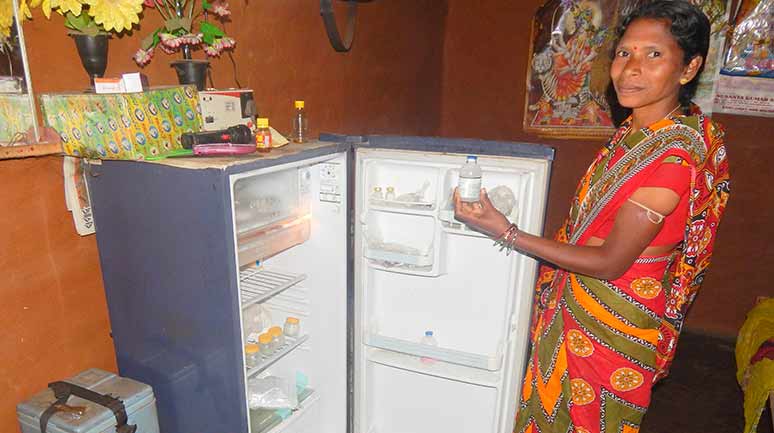
Some of the para-vets decided to leave after hearing these allegations. However, after sustained discussions with the women, their husbands, families and SHG members, PRADAN professionals, gradually, helped the para-vets change their decision. Once they got support from their family, they became determined to do something for themselves and the others and continued their trainings and work. So, the first couple of years of the initiation of the activity were difficult. There was a questioning of the outcomes of the activity and there was a violation of social harmony.
So, the first couple of years of the initiation of the activity were difficult. There was a questioning of the outcomes of the activity and there was a violation of social harmony
S ebati Digal, (an expert para-vet) recalls, “My husband shut the door and didn’t allow me to enter the house when I got late coming back from the training one day. A PRADAN professional came and talked to him, only then did he let me in.”
Pusari Digal, is a member of the Unnatipatha Cheli Samiti, of Jargi village. She has never had any formal education but has been trained as a para-vet and is one of the first women para-vets. She shares,“I am illiterate, and could not read the names of the medicines. I marked the medicines in pen and remembered them. My hands shook when I first held the injection. It took me a lot of time to hold it steadily. Once I gave the injection successfully, my fear went off. I had never thought I could ever do it, and I am glad that now I can.”
So, the first couple of years of the initiation of the activity were difficult. There was a questioning of the outcomes of the activity and there was a violation of social harmony.
Realizing the difficulties, the women’s Cluster worked consistently to support the para-vets. Gradually, the women mastered everything, from open castration to handling difficult cases. With the efforts of these women para-vets, there was a significant shift in the villages with regard to livestock- rearing. From the inception of this activity, there has been no outbreak of deadly diseases, the mortality rate has decreased to less than 4 per cent (the standard adult mortality rate is 8 per cent) and the average stock size has increased from 2 to 20 in this Cluster. With each successful case, people’s perception of women para-vets is changing.
Pushpita Mallick a para-vet of the Cluster shares, “When I started goat-rearing I had only one mother goat, now I have 12. With the growth of my stock (now 23), I have also grown. When my SHG members selected me as a para-vet, I was reluctant at first. I hesitated to speak before a gathering. Now I go to different places as an expert to train other women like me. When I go out, my husband takes care of my children and the house. He takes care of the livestock too. Going to villages for training and interacting with women, gives me a unique sense of solidarity and through this I feel I have achieved many things in life.”
Not only the para-vets but all the women too have developed confidence in this activity. The men, who once had a limited role in this activity, have started lending a hand in taking care of livestock. In families where getting year-round ration had been a struggle, this activity has contributed to providing food. The authority with which the women now assert their views has been a long time coming. The women, who used to shy away from speaking, are now negotiating with traders for selling their livestock. Those who were dependent on men’s permission for spending any money, have now started saving the income from livestock in their own bank accounts.
Livestock is not only looked at as a source of income by these women but it also holds a special place in their hearts. While taking care of their livestock, they develop an attachment to it as they would for their own child. Women share how difficult it is when they have to sell their goats. They do not consume its meat because of the affection they have for the animals
Livestock is not only looked at as a source of income by these women but it also holds a special place in their hearts. While taking care of their livestock, they develop an attachment to it as they would for their own child. Women share how difficult it is when they have to sell their goats. They do not consume its meat because of the affection they have for the animals
R aji Digal, a women rearer from Kateribahat village, says, “We women look after the livestock, we clean their shed, we give them medicine, we take care of them like our kids so they belong to us. We own the livestock and we own the money out of it.”
Livestock is not only looked at as a source of income by these women but it also holds a special place in their hearts. While taking care of their livestock, they develop an attachment to it as they would for their own child. Women share how difficult it is when they have to sell their goats. They do not consume its meat because of the affection they have for the animals.
The Livestock Production Cluster
L ooking at the ease of carrying out the activity, and the economic return with respect to labour, the women have started adopting this activity as a major livelihood option. In order to strengthen the activity and create a model, there was a need to collectivize.In 2010, these women formed a goat production cluster named, ‘Unnatipatha Cheli Samiti’, to combat a few of the higher order issues that arise during operations and scaling up of the activity.
Starting in 2006 with 30 families, the activity reached 100 families in four villages by 2010. Thus, that year, the Unnatipatha Cheli Samiti was constituted. It has a President and 12 Board members elected from among them. An annual membership fee of Rs 100 is being collected from each rearer. Along with the SHG-wise collection that is done at the Cluster level to create a pool of funds; savings are made separately by each Cluster member for the vaccination and medication of livestock in their respective SHGs. The women, in each SHG, maintain a separate rearer card to record their individual transactions.
All the transactions that take place in the monthly meetings of the Cluster are recorded in the cash book maintained by the book-keeper. The funds are then deposited in the bank; currently they have Rs 60,000 in their bank account. The money is utilized for procuring vaccines, medication, feed and purchase of quality buck. The Cluster also supports women in need by providing them with a loan, to carry out this livelihood activity.
Each member of the Cluster follows the improved practices. They have spent their own resources to construct their goat shed. Through this intervention, the average income of the families from livestock has now come up to Rs 20,000 to 30,000 per annum.
Punjungi Mallick of Kateribhata village proudly tells us about the gold jewellery that she bought that year for her daughter’s marriage by selling her goat for Rs 25,000.
“I take care of my goats, I myself go to Balliguda to buy medicines and conduct the de-worming by myself. My husband doesn’t understand anything. I manage the money, now. I buy clothes for myself and my husband; Last year, the money I got from livestock, I spent it in the construction of my house.”
During the regular monthly meetings, the functioning of para-vets and also SHGs are reviewed, around the livestock calendar. The members have undergone capacity building trainings around improved practices. The members of each SHG have been trained to provide basic care and medication to their livestock. The Cluster looks after the vaccination needs of each SHG and has links to other stakeholders such as the Veterinary Department for vaccines and the purchase of poultry birds. The Cluster has also planned and has been pursuing the panchayat, to converge for shed construction through MGNREGA.
The activity started with small ruminants; subsequently, the Cluster took up backyard poultry. Mass awareness has altered the community’s view from being a fatalistic one to an indeterminist one. Earlier, their cattle’s health was ignored and, in case of disease, its survival was left to fate; however, now they have started treatment of large ruminants also. When their cattle fell sick, they usually contacted the Livestock Inspector of their concerned GP and spent money on its treatment. Treatment for simple ailments and problems of cattle is now taken up by women para-vets.
Aiming to increase the scale of this activity and reach out to all the other women rearers, the Cluster arranged an exposure to their village. The people from many GPs, other districts, government officials and stakeholders visit their Cluster, to understand the livestock model and witness the change that has taken place because of the efforts of the women.
The Cluster has also established a link with the outside traders for selling goats. The women no longer have to go to the market looking for a buyer and a suitable price. Looking at the scale and the quality produced at that Cluster, traders now directly arrive at their doorstep to buy goats. The women negotiate with the traders and sell the goats even in the absence of the men of the household.
Tinuri Digal, of Jargi village shares with a smile, “Once my husband went to Balliguda market to sell the goats. He couldn’t negotiate with the buyers so he returned disheartened. The next day, I went to the market and sold the goats for Rs 20,000.”
Small Steps to Change
Having ownership over the stock or control over the income is rare among women rearers. Certainly, these factors are barriers to women’s empowerment; the greatest drawback, however, is a woman’s self-perception. Her view of herself,(that of being a worker and not an owner) time and again, limits their growth.
Having ownership over the stock or control over the income is rare among women rearers. Certainly, these factors are barriers to women’s empowerment; the greatest drawback, however, is a woman’s self-perception. Her view of herself,(that of being a worker and not an owner) time and again, limits their growth.
T raditionally, in our society, a woman’s role in an economic activity has always been devalued and has never been recognized or appreciated. The women perform all the day-to- day activities related to caring, feeding, cleaning and looking after the health and production of livestock. And yet, these are considered to be low-skill activities. Having ownership over the stock or control over the income is rare among women rearers. Certainly, these factors are barriers to women’s empowerment; the greatest drawback, however, is a woman’s self-perception. Her view of herself, (that of being a worker and not an owner) time and again, limits their growth.
Slowly, this notion has started to change; the tables have started to turn in this Cluster. For the last six years, women have been managing this activity and the Cluster by themselves. They have started to realize their own potential and are fighting and demanding equal rights over the assets that they have built through their toil and sweat.Smaller steps, taken by these collectives, have led them to where they have reached today. They now have greater access to knowledge, information and exposure to the outside world. Access to the market has increased their mobility, which was earlier limited and was the privilege of men. Women here are no longer dependent on their husbands, brothers or sons. They started as labourers and are slowly becoming owners.
“Recently, when my husband’s phone broke, I went and bought a smart phone for him. He was surprised and happy to see his gift. I was happy because I bought it from my own money; now, I do not depend upon anyone.” Sebati Digal
Akankhya Parida is based in Balliguda, Odisha

